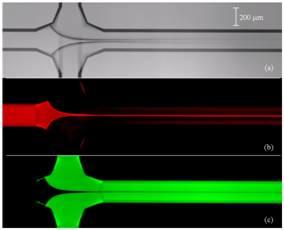Summary
Liposomes are nanometer-sized spherical vesicles made of phospholipids similar to those found in cell membranes of living organisms. Traditional techniques to form liposomes include methods such as hydration of a dried lipid film with aqueous media or injection of a lipid solution into a well mixed aqueous buffer. To date, these liposome formation methods occur on a length scale that is several orders of magnitude greater than the length scale of the liposomes (i.e. centimeters for the former vs. nanometers for the latter). This mismatch in length scales result in variable physicomechanical and chemical environments in both space and in time, which produces liposomes that vary in size and size distribution from batch to batch as well as in a given batch. This variability necessitates post-formation processing steps (such as sonication or extrusion through porous membranes) to produce liposomes with the desired size and size distribution.
At NIST, we have developed a microfluidic method to produce nanoparticles including liposomes and other vesicular systems. This method uses hydrodynamic focusing to sandwich an alcohol-lipid mixture into a very narrow central stream between two aqueous streams. The flow in this microfluidic system (and most microfluidics in general) is purely laminar with Reynold's numbers rarely exceeding 20. This enables controlled and reproducible fluidic flow characteristics eliminating much of the uncontrolled physicomechanical and chemical variability intrinsic to larger size scale systems. Further, by adjusting the relative flow rates of the alcohol-lipid stream to the aqueous streams as well as the total volumetric flow rate, lipids form into liposomes of various controlled sizes and size distributions. Additionally, our work has included experiments and mathematical modeling to elucidate the factors controlling liposome size.
Description

Liposomes have found many applications, including targeted drug delivery, immunoassay amplification, and medical imaging. For targeted drug delivery and medical imaging applications, the microfluidic-synthesis method could allow the synthesis of liposomes at the point of care, so that problems with long-term storage of liposomes, such as lipid degradation and leakage of encapsulated material, could be avoided. In addition, the tight control of size distributions may help improve targeting to specific sites, such as tumors, and decrease their clearance from the body through renal filtration or immunological recognition and clearance.

